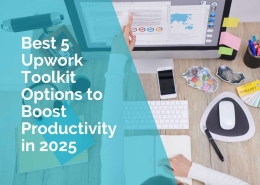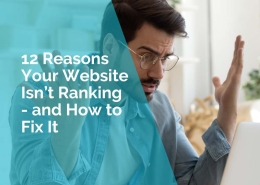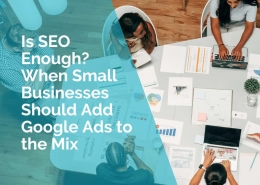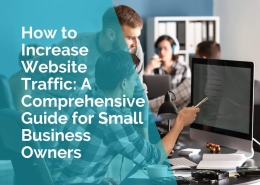12 Reasons Your Website Isn’t Ranking – and How to Fix It
Your website might look great — clean design, well-written copy, and even a few blog posts. But if you’re nowhere to be found in Google’s search results, it’s likely costing you leads, customers, and revenue.
Search engine visibility is critical. Most online experiences begin with a search engine, and users never scroll past the first page of results. If your site isn’t showing up, potential customers are finding your competitors instead.
The good news? Google isn’t hiding its ranking secrets. Many of the reasons your website isn’t ranking are fixable — once you know where to look.
Here are 10 of the most common reasons your website may not be ranking, plus actionable tips to help you climb the search results.
1. You’re Targeting the Wrong Keywords
If your website content isn’t built around what your audience is searching for, you’ll struggle to appear in search results — no matter how polished your content is.
Common pitfalls:
- Going after overly broad or competitive terms
- Using jargon that customers don’t search for
- Ignoring long-tail keywords with strong intent
Fix it:
- Research keywords using tools like Ubersuggest, Ahrefs, or Google Keyword Planner
- Prioritise long-tail keywords (e.g. “best accountant for tradies Sydney”)
- Optimise page titles, meta descriptions, headings, image alt tags, and URLs with your target keywords — naturally
2. Technical SEO Issues Are Blocking Search Engines
Search engines need to crawl and index your website to rank it. If your site has technical issues, it may not be getting indexed properly or at all.
Red flags:
- Broken links (404 errors)
- Slow-loading pages
- Mobile usability errors
- Duplicate meta tags
- No SSL certificate (HTTPS)
Fix it:
- Use Google Search Console to check for indexing or crawl errors
- Run your site through Screaming Frog or Sitebulb to identify technical SEO issues
- Compress images, implement lazy loading, and enable caching to speed up load times
- Secure your site with an SSL certificate
Pro Tip: Your site should be mobile-first, not just mobile-friendly. Google uses mobile-first indexing, so the performance of your website on smartphones directly affects your rankings.
3. Your Content Doesn’t Offer Real Value
Thin or generic content might tick a box, but it won’t rank — and more importantly, it won’t engage your visitors. Google’s algorithm rewards expertise, authority, and trustworthiness (E-E-A-T).
Fix it:
- Create original, in-depth content that solves real problems
- Add examples, case studies, and customer stories where relevant
- Include structured headings (H2s and H3s) and answer key questions your audience might ask
Bonus:
Enhance your content’s interactivity and engagement by embedding Notion widgets. These allow you to include polls, countdown timers, testimonials, and more — boosting user experience and encouraging longer on-page sessions.
4. You Don’t Have Enough Quality Backlinks
Backlinks (links from other websites to yours) are one of Google’s top three ranking factors. If no one is linking to your site, search engines may assume your content lacks authority.
Fix it:
- Guest post on relevant industry blogs and include a link back to your site
- Create share-worthy resources like calculators, templates, or original research
- Reach out to websites that have mentioned your brand or niche but haven’t linked back (a tactic known as “link reclamation”)
Remember: it’s about quality over quantity. One link from a respected, high-authority website is worth more than dozens of spammy ones.
5. Your Website Isn’t Optimised for Mobile
Most searches happen on mobile devices. If your site doesn’t work well on phones and tablets, not only will users bounce, but Google will downgrade your rankings.
Fix it:
- Use a responsive design that adapts to any screen size
- Test your site using Google’s Mobile-Friendly Test.
- Avoid using small fonts, buttons that are difficult to tap, and horizontal scrolling.
Mobile usability directly affects bounce rate, time on site, and other ranking signals — so don’t treat it as an afterthought.
6. You’re Ignoring Local SEO
If you’re a small business that serves a local area, local SEO can be a goldmine — but only if you’re optimised for it.
Fix it:
- Create and verify a Google Business Profile
- Add your business to local directories like Yelp, Yellow Pages, and TrueLocal
- Include location-specific keywords (e.g. “plumber in Newcastle”)
- Use consistent NAP (Name, Address, Phone Number) details across all platforms.
Encourage satisfied customers to leave Google reviews, which not only improve trust but also serve as a ranking factor for local search.
7. Your Site Has Poor User Experience (UX)
Even if your content is excellent, a clunky or confusing website will drive visitors away — and Google tracks these negative signals.
UX problems that hurt rankings:
- Slow-loading pages
- Confusing navigation
- Intrusive pop-ups
- Difficult-to-read text
Fix it:
- Improve page speed using tools like GTmetrix or Google PageSpeed Insights
- Use a clean layout with clear headings, bullet points, and white space
- Structure your navigation so visitors can find key pages in 1–2 clicks
A good rule of thumb: if a visitor lands on your site and doesn’t know what to do next within 5 seconds, your UX needs work.
8. Your Content Isn’t Being Updated
Google wants to deliver fresh, relevant results to users. If your blog posts or service pages haven’t been touched in years, they’ll likely drop in rankings.
Fix it:
- Update old blog posts with new stats, internal links, and better structure
- Add new sections or FAQs to evergreen content
- Republish updated content with a new “last updated” date to signal freshness
Content maintenance is just as essential as creation. Schedule a quarterly audit to refresh your highest-value pages.
9. Your Internal Linking Is Weak
Internal links help distribute page authority and guide visitors through your website, boosting both SEO and user experience.
Fix it:
- Link related blog posts together naturally
- Add internal links from high-authority pages (like your homepage or pillar content) to newer pages
- Use descriptive anchor text (e.g. “check out our email marketing guide” instead of “click here”)
Avoid keyword-stuffing your anchor text, but ensure it clearly indicates the content of the linked page.
10. You’re Competing in a Saturated Market Without a Strategy
Some industries are incredibly competitive online. If you’re publishing similar content to everyone else, you’ll struggle to stand out — let alone rank.
Fix it:
- Identify a niche or angle your competitors aren’t covering
- Focus on content gaps — topics your audience cares about but aren’t well-served in search
- Use tools like AlsoAsked or AnswerThePublic to find questions real users are asking
Be strategic. A smaller but well-defined content strategy will outperform a broad, scattershot approach every time.
11. You’re Not Leveraging Structured Data
Structured data (or schema markup) helps Google understand your content and can lead to enhanced listings (like star ratings, event info, and product details).
Fix it:
- Use tools like Merkle’s Schema Generator or Yoast SEO Premium (for WordPress)
- Add schema types like FAQ, Product, Local Business, or Review, depending on your content.
Rich results stand out in the SERPs and can increase click-through rates significantly.
12. You Lack a Clear Content Strategy
Publishing random blog posts with no plan leads to missed opportunities. You need a strategy that aligns content with user intent and business goals.
Fix it:
- Define 3–5 core content pillars relevant to your audience
- Map keywords to the stages of the buyer journey (awareness, consideration, decision)
- Use a content calendar to plan consistent publishing and updates.
Pro tip: Combine your content strategy with SEO data to make smarter decisions about what to create and when.
Start With the Basics — Then Build Up
Ranking on Google isn’t about chasing shortcuts. It’s about building a trustworthy, valuable, and technically sound website that delivers an exceptional user experience.
If your site isn’t ranking, start with the basics:
- Target the right keywords
- Fix technical issues
- Improve content quality
- Focus on user experience and mobile optimisation
- Earn quality backlinks and keep your content fresh.
Then, build on that with local SEO, structured data, and a clear content strategy. SEO is an investment — and every improvement you make compounds over time.
Ready to Start Climbing the Rankings?
Choose one issue from the list above and take action this week. Whether it’s optimising your content or claiming your Google Business Profile, the best time to start fixing your SEO is now. Minor, focused improvements today can lead to significant results in the months ahead.
***
by Paula Salvidar










